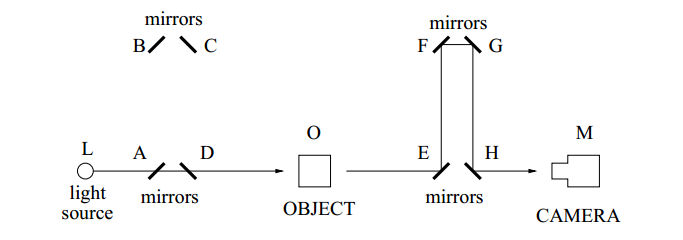How to Build a Time Cloak with Mirrors
The ability to hide objects in space– invisibility cloaking– has leapt from the world of science fiction to practical reality within 10 years. But the ability to hide objects in time– temporal cloaking– is evolving even faster.

During the last two years, physicists have begun using exotic metamaterials to create holes in time. The first time cloak lasted only for 100 nanoseconds or so. But last month, researchers showed how to cloak data almost half of the time. That’s an impressive improvement.
Today, Miguel Lerma at Northwestern University in Evanston, Illinois, goes even further. Lerma has worked out how to build time cloaks that can operate for arbitrarily long periods of time using little more than a few cleverly placed mirrors.
The basic idea behind time cloaking is simple. Imagine viewing a clock illuminated by a laser. In ordinary circumstances, the light leaves the laser, travels to the clock and reflects towards you, the observer. At each stage, the speed of light is constant.
The trick behind time cloaking is to slow down light before it reaches the clock creating a gap in which the movement of the clock is not illuminated. You, the observer, cannot see what happens during this time.
However, by speeding up the light again after it has been reflected, it is possible to close the gap so that you do not notice any change in illumination either.
Instead, you see the clock jump from one moment to a later time without anything in between. “The distant observer therefore only sees a continuous illumination, whilst the events that occurred during the dark period of the cloak’s operation remain undetected,” says Lerma.
In effect, this process has created a hole in time during which events are hidden.
That’s the theory. The practice is more involved. The enabling technologies that have made this type of time cloaking possible are so-called metamaterials that can slow down and speed up light. These are difficult and complex to make.
But Lerma points out today that this kind of exotic stuff is not necessary. Instead, he shows how to achieve time cloaking using a set of mirrors that can be switched on or off. His idea is to use one set of mirrors to divert light through an extra distance before it reaches the clock and another set of mirrors that diverts light through a similar distance after it has hit the clock.
This extra distance essentially slows down the lights before it hits the clock. After it has been reflected, the light can be speeded up by avoiding the diversion so that it does not travel the extra distance.
This creates a gap during which any change the clock cannot be seen. However, an observer watching the clock sees it jump in time without any change in illumination.
Lerma’s device is interesting because it works for all frequencies of light that the mirrors reflect. Metamaterials, on the other hand, generally work only at specific frequencies. “”We have shown how to create an event cloak device without the use of metamaterials, by a simple arrangement of switchable transreflective mirrors,” says Lerma.
The new approach creates temporal holes that are equal to the time it takes the light to travel the extra distance. So by making this distance arbitrarily long, by bouncing the light back and forth off the Moon or for example, it ought to be possible to make holes in time of almost any length.
That’s an impressively simple trick but it is not the first time that physicists have shown that invisibility cloaks are actually much easier to make than had been thought. A couple of months ago, physicists unveiled an invisibility cloak that used mirrors rather than metamaterials to hide objects of almost any size.
Lerma is a mathematician and so unlikely to want to get his hands dirty in the lab. However, his machine requires no new components–the mirror technology it relies on is available now.
So there’s no reason why this time machine couldn’t be built tomorrow. Indeed, expect to see the first demonstration in the coming weeks or months.
Ref: arxiv.org/abs/1308.2606 : A Mirror Based Event Cloaking Device
Keep Reading
Most Popular
Large language models can do jaw-dropping things. But nobody knows exactly why.
And that's a problem. Figuring it out is one of the biggest scientific puzzles of our time and a crucial step towards controlling more powerful future models.
How scientists traced a mysterious covid case back to six toilets
When wastewater surveillance turns into a hunt for a single infected individual, the ethics get tricky.
The problem with plug-in hybrids? Their drivers.
Plug-in hybrids are often sold as a transition to EVs, but new data from Europe shows we’re still underestimating the emissions they produce.
Google DeepMind’s new generative model makes Super Mario–like games from scratch
Genie learns how to control games by watching hours and hours of video. It could help train next-gen robots too.
Stay connected
Get the latest updates from
MIT Technology Review
Discover special offers, top stories, upcoming events, and more.